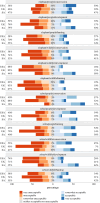Public perceptions of trophy hunting are pragmatic, not dogmatic
- PMID: 38351797
- PMCID: PMC10865007
- DOI: 10.1098/rspb.2023.1638
Public perceptions of trophy hunting are pragmatic, not dogmatic
Abstract
Fierce international debates rage over whether trophy hunting is socially acceptable, especially when people from the Global North hunt well-known animals in sub-Saharan Africa. We used an online vignette experiment to investigate public perceptions of the acceptability of trophy hunting in sub-Saharan Africa among people who live in urban areas of the USA, UK and South Africa. Acceptability depended on specific attributes of different hunts as well as participants' characteristics. Zebra hunts were more acceptable than elephant hunts, hunts that would provide meat to local people were more acceptable than hunts in which meat would be left for wildlife, and hunts in which revenues would support wildlife conservation were more acceptable than hunts in which revenues would support either economic development or hunting enterprises. Acceptability was generally lower among participants from the UK and those who more strongly identified as an animal protectionist, but higher among participants with more formal education, who more strongly identified as a hunter, or who would more strongly prioritize people over wild animals. Overall, acceptability was higher when hunts would produce tangible benefits for local people, suggesting that members of three urban publics adopt more pragmatic positions than are typically evident in polarized international debates.
Keywords: conservation conflicts; politics; social acceptability; sustainable use; wildlife conservation.
Conflict of interest statement
D.H. receives funding for the Morally Contested Conservation (MCC) research project from Jamma International, WWF Deutschland, and the Luc Hoffmann Institute (now Unearthodox). B.J.R., Y.M., S.K., L.S. and D.K. receive funding through the MCC project. S.K. has previously received funding from the Weatherby Foundation. A.D. is a consultant for Jamma International, Director of the Wildlife Conservation Research Unit (WildCRU) at Oxford University, and joint CEO of Lion Landscapes. WildCRU and Lion Landscapes have received funding from donors with a variety of stances on trophy hunting (in both cases with more funding from donors against trophy hunting than for it), none of which funded the work presented here. L.M. has received funding from Jamma International for research separate from the work presented here. A.J.D., Y.M. and L.M. are members of the IUCN Sustainable Use and Livelihoods Specialist Group. A.D. and L.S. are members of the African Lion Working Group, which is affiliated with the IUCN Cat Specialist Group. WWF Deutschland, Jamma International, the IUCN Sustainable Use and Livelihoods Specialist Group and the African Lion Working Group contribute to international policy discourses around wildlife conservation in Africa, including community-led wildlife conservation and hunting. P.J.J. and C.S. declare no competing interests.
Figures





References
-
- IUCN. 2016. Informing decisions on trophy hunting. See https://wwfint.awsassets.panda.org/downloads/iucn_informingdecisionsontr... (accessed 25 January 2023).
-
- IUCN. 2012. Guiding principles on trophy hunting as a tool for creating conservation incentives. See https://portals.iucn.org/library/efiles/documents/Rep-2012-007.pdf (accessed 20 July 2023).
-
- Dickman AJ, et al. . 2019. Is there an elephant in the room? A response to Batavia et al. Conserv. Lett. 12, e12603. (10.1111/conl.12603) - DOI
-
- Batavia C, Nelson MP, Darimont CT, Paquet PC, Ripple WJ, Wallach AD. 2019. The elephant (head) in the room: a critical look at trophy hunting. Conserv. Lett. 12, e12565. (10.1111/conl.12565) - DOI
-
- Mkono M. 2019. Neo-colonialism and greed: Africans' views on trophy hunting in social media. J. Sustain. Tour. 27, 689-704. (10.1080/09669582.2019.1604719) - DOI
MeSH terms
Grants and funding
LinkOut - more resources
Full Text Sources
Other Literature Sources

